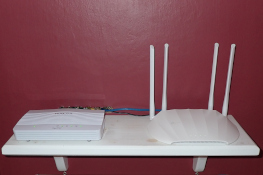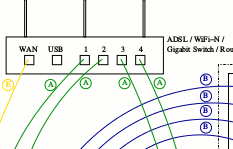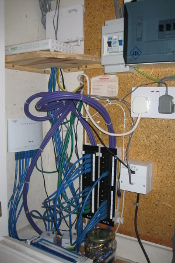House Gigabit Network
As every tech geek knows, the only way to have a house network is with wires. Yes wireless is easy and convenient, but the more things you have "connected" to it at the same time, the slower it goes! And yes, I know that's a wireless access point in the photo, but read on...
So, having bought a new house with my (then) wife Helen, my first job was to wire CAT6 cable into every room. Initially I wasn't allowed to do the kitchen, but after Helen discovered the convenience of having instant access to her (and my) entire CD collection at the touch of a button, she asked if it was possible to get that in the kitchen ... permission granted (also meant having to make a Kitchen Jukebox :-)
Before I'd moved in (in 2009), I checked with SamKnows and realised that I'd be dropping my ADSL bandwidth: from a full 8Meg in Gullane to approximately 2Meg in Stirling so I had to take steps to maximise what I was getting :-(
However, on the 31st October 2011 I became the first person on my estate to be connected to the new FTTC DSLAM cabinet out on the street and as it turned out, the first VDSL connection actually working in Stirling as for the 30 previous connections, the exchange had a few teething problems (so said the man from BT).
So, goodbye sync rates of ~2Meg and hello ~38Meg :-)
Between November 2012 and January 2015, I was participating in the SamKnows / Ofcom monitoring survey to see just how good FTTC broadband connections around the country are. Pretty good as it turns out! Anyway, after the survey had finished, SamKnows told me that they didn't want their "White Box" back as it was the old style. So I installed DD-WRT on it and was using it as my Wi-Fi router for a while. However, now it and my old Billion router are spare, to make way for slightly more modern technology.
Equipment Used
- 1 x BT OpenReach Broadband Faceplate
- 1 x
DrayTek Vigor 2762
- VDSL2 / ADSL / 3G / 4G router
- 4-port gigabit Ethernet switch (10 / 100 / 1000)
- 2x USB ports for 3G/4G modem or storage
- 1 x
TP-Link TP-WA1201 AC1200 Access Point
- 802.11ac ( 876 Mbps @ 5GHz & 300 Mbps @ 2.45GHz )
- Ethernet LAN (10 / 100 / 1000) for network
- 1 x
TP-Link TP-WR1043ND Wireless N Router
( Modified to run
OpenWrt )
- Configured as WiFi access point / gigabit switch
- 802.11n ( 300 Mbps @ 2.45GHz )
- 4-port gigabit Ethernet switch (10 / 100 / 1000)
- 3 x D-Link DGS-1008D 8 port 10 / 100 / 1000 Mbps Switch
- 1 x D-Link DGS-1005D 5 port 10 / 100 / 1000 Mbps Switch
- 1 x D-Link DGS-105 5 port 10 / 100 / 1000 Mbps Switch
- 2 x 12 port CAT6 patch panels, wall mounted
- 8 x 2 port CAT6 single gang face plates
- 1 x 4 port CAT6 double gang face plates
- 200 metres (approximately) of CAT6 solid core cable
- Lots of CAT6 patch cables
Spare Equipment
- 1 x BT OpenReach VDSL modem
Wiring Schematic
This is now a ![]() since
it's quite a large diagram and doesn't look good as a bitmap.
since
it's quite a large diagram and doesn't look good as a bitmap.
Basically all of the dotted lines are hard wired into the house and all of the solid lines are patch leads.
The Data Hub
All of these connections come to a central point, which conveniently is also where the mains electricity and BT phone cable come into the house: in a wee cupboard in the hallway.
See how enormous the BT OpenReach Broadband master socket is - 3 layers thick! The socket also has a phone connected, a slave wired into the back of it to the computer room and another slave to the living room (for Sky boxes etc.)
The socket of course, has a connection to the VDSL modem built into the latest router (Netgear D7000 which sits on a shelf outside the cupoboard), but I'm keeping the original BT VDSL model screwed to the wall at the back, just in case it's ever needed.
The patch panels are screwed to the wall in a convenient place to allow routing of all of the cables (with room for future expansion, of course).
One gigabit switches sits on the shelf with LEDs on the front and cables into the rear, another has been moved onto the wall for neatness. The third switch is actually in the computer room as it's where I connect things on an ad-hoc basis. The fourth sits behind the TV as it was getting to messed up with wires behind there with 4 cables going to the wall.
Purple cables are the house infrastructure, i.e. from the patch panels to the face-plates in all of the rooms. Most are routed into the rafters in between the ground and first floor and into the eves before reaching their destination. A handful are routed through the crawl-space under the ground floor.
Green cables connect the switches (including router) together.
Blue cables connect devices to a switch/router.
The Yellow cable is the WAN connection from the WiFi / Router to the BT VDSL modem (a backup in case the router's built-in VDSL modem packs in).










Computing Power
- Acer Aspire R3700
- Acknowledgements
- BOINC
- Desktop PC
- Eee PC 4G (701)
- Eee PC 901
- Gigabit Network
- Inspiron 14 5485 Laptop
- Kids PC 1
- Kids PC 2
- Media PC
- Mini-ITX PC
- My Useful Scripts
- Nano ITX PC
- Nook Simple Touch
- Processing Power *
- Raspberry Pi (*)
- Sharp Zaurus SL-C3200
- Storage Capacity *
- The Server
- What Is Firmware






![Validate my Atom 1.0 feed [Valid Atom 1.0]](./images/valids/valid-atom10-yellow.gif)
![Validate my RSS 2.0 feed [Valid RSS 2.0]](./images/valids/valid-rss20-yellow.gif)